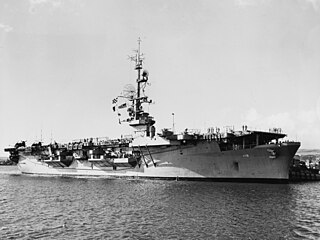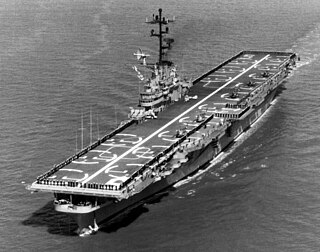 W
WThe Essex class was a class of aircraft carriers of the United States Navy. The 20th century's most numerous class of capital ship, the class consisted of 24 vessels, which came in "short-hull" and "long-hull" versions. Thirty-two ships were ordered, but as World War II wound down, six were canceled before construction, and two were canceled after construction had begun. Fourteen ships of the class engaged in combat operations during World War II. No Essex-class ships were lost to enemy action even though several sustained crippling damage. The Essex-class carriers were the backbone of the U.S. Navy's combat strength during World War II from mid-1943 on, and, along with the three Midway-class carriers added just after the war, continued to be the heart of U.S. naval strength until the supercarriers came into the fleet in numbers during the 1960s and 1970s.
 W
WThe Independence-class aircraft carriers were a class of light carriers built for the United States Navy that served during World War II.
 W
WThe Commencement Bay-class escort aircraft carriers were the last class of escort carriers built for the US Navy in World War II.
 W
WUSS Antietam (CV/CVA/CVS-36) was one of 24 Essex-class aircraft carriers built during and shortly after World War II for the United States Navy. The ship was the second US Navy ship to bear the name, and was named for the American Civil War Battle of Antietam (Maryland). Antietam was commissioned in January 1945, too late to serve actively in World War II. After serving a short time in the Far East, she was decommissioned in 1949. She was soon recommissioned for Korean War service, and in that conflict earned two battle stars. In the early 1950s, she was redesignated an attack carrier (CVA) and then an antisubmarine warfare carrier (CVS). After the Korean War she spent the rest of her career operating in the Atlantic, Caribbean, and Mediterranean. From 1957 until her deactivation, she was the Navy's training carrier, operating out of Florida.
 W
WUSS Badoeng Strait (CVE-116) was a Commencement Bay-class escort carrier of the United States Navy during the Korean War.
 W
WUSS Bairoko (CVE-115) was a Commencement Bay-class escort carrier of the United States Navy in service from 1945 to 1955.
 W
WUSS Bataan (CVL-29/AVT-4), originally planned as USS Buffalo (CL-99) and also classified as CV-29, was an 11,000 ton Independence-class light aircraft carrier which was commissioned in the United States Navy during World War II on 17 November 1943. Serving in the Pacific Theatre for the entire war, taking part in operations around New Guinea, the Invasion of the Mariana Islands, the Battle of the Philippine sea, the Battle of Okinawa, and Attacks on the Japanese home islands. After World War II's end she was converted into an anti-submarine carrier and placed in reserve on 11 February 1947.
 W
WUSS Bon Homme Richard (CV/CVA-31) was one of 24 Essex-class aircraft carriers completed during or shortly after World War II for the United States Navy. She was the second US Navy ship to bear the name, the first one being named for John Paul Jones's famous Revolutionary War frigate by the same name. Jones had named that ship, usually rendered in more correct French as Bonhomme Richard, to honor Benjamin Franklin, the American Commissioner at Paris, whose Poor Richard's Almanac had been published in France under the title Les Maximes du Bonhomme Richard.
 W
WUSS Boxer was one of 24 Essex-class aircraft carriers of the United States Navy, and the fifth ship to be named for HMS Boxer. She was launched on 14 December 1944 and christened by the daughter of a US Senator from Louisiana.
 W
WUSS Corregidor (AVG/ACV/CVE/CVU-58) was the fourth of fifty Casablanca-class escort carriers built to serve the United States Navy during World War II. Launched in May 1943, and commissioned the following August, she was originally named for Anguilla Bay, in Maurelle Island, in the Alexander Archipelago, of Alaska.
 W
WUSS Essex (CV/CVA/CVS-9) was an aircraft carrier and the lead ship of the 24-ship Essex class built for the United States Navy during World War II. She was the fourth US Navy ship to bear the name. Commissioned in December 1942, Essex participated in several campaigns in the Pacific Theater of Operations, earning the Presidential Unit Citation and 13 battle stars. Decommissioned shortly after the end of the war, she was modernized and recommissioned in the early 1950s as an attack carrier (CVA), eventually becoming an antisubmarine aircraft carrier (CVS). In her second career, she served mainly in the Atlantic, playing a role in the Cuban Missile Crisis. She also participated in the Korean War, earning four battle stars and the Navy Unit Commendation. She was the primary recovery carrier for the Apollo 7 space mission.
 W
WUSS Kearsarge (CV/CVA/CVS-33) was one of 24 Essex-class aircraft carriers completed during or shortly after World War II for the United States Navy. The ship was the third US Navy ship to bear the name, and was named for a Civil War-era steam sloop. Kearsarge was commissioned in March 1946. Modernized in the early 1950s as an attack carrier (CVA), she served in the Korean War, for which she earned two battle stars. In the late 1950s she was further modified to become an anti-submarine carrier (CVS). Kearsarge was the recovery ship for the last two manned Project Mercury space missions in 1962–1963. She completed her career serving in the Vietnam War, earning five battle stars.
 W
WUSS Lake Champlain (CV/CVA/CVS-39) was one of 24 Essex-class aircraft carriers completed during or shortly after World War II for the United States Navy. She was the second US Navy ship to bear the name, and was named for the Battle of Lake Champlain in the War of 1812.
 W
WUSS Leyte was one of 24 Essex-class aircraft carriers built during and shortly after World War II for the United States Navy. The ship was the third US Navy ship to bear the name. Leyte was commissioned in April 1946, too late to serve in World War II. She spent most of her career in the Atlantic, Caribbean, and Mediterranean, but also saw service in the Korean War, in which she earned two battle stars. She was reclassified in the early 1950s as an attack carrier (CVA), then as an Antisubmarine Aircraft Carrier (CVS), and finally as an aircraft transport (AVT).
 W
WUSS Oriskany (CV/CVA-34) – nicknamed Mighty O, and occasionally referred to as the O-boat – was one of the few Essex-class aircraft carriers completed after World War II for the United States Navy. The ship was named for the Battle of Oriskany during the Revolutionary War.
 W
WUSS Philippine Sea was one of 24 Essex-class aircraft carriers of the United States Navy, and the first ship to be named for the Battle of the Philippine Sea. She was launched on 5 September 1945, after the end of World War II, and sponsored by the wife of the Governor of Kentucky.
 W
WUSS Point Cruz (CVE-119) was a Commencement Bay-class escort carrier of the United States Navy. Originally named Trocadero Bay until 5 June 1944 when it was renamed after the Honiara suburb Point Cruz, which was an important location during the Guadalcanal Campaign. She was laid down on 4 December 1944 by Todd-Pacific Shipyards Incorporated, Tacoma, Washington; launched on 18 May 1945, sponsored by Mrs. Earl R. DeLong; and commissioned on 16 October 1945, with Captain Douglas T. Day in command.
 W
WUSS Princeton was one of 24 Essex-class aircraft carriers built during and shortly after World War II for the United States Navy. The ship was the fifth US Navy ship to bear the name, and was named for the Revolutionary War Battle of Princeton. Princeton was commissioned in November 1945, too late to serve in World War II, but saw extensive service in the Korean War, in which she earned eight battle stars, and the Vietnam War. She was reclassified in the early 1950s as an attack carrier (CVA), then as an Antisubmarine Aircraft Carrier (CVS), and finally as an amphibious assault ship (LPH), carrying helicopters and marines. One of her last missions was to serve as the prime recovery ship for the Apollo 10 space mission.
 W
WUSS Rendova (CVE-114) was a Commencement Bay-class escort carrier of the United States Navy.
 W
WUSS Sicily (CVE-118) was a Commencement Bay-class escort carrier in the United States Navy. She was named in honor of the island of Sicily, which was the site of a major invasion during World War II. Sicily was laid down on 23 October 1944 by Todd-Pacific Shipyards, Tacoma, Washington, as Sandy Bay; launched on 14 April 1945; sponsored by Mrs. Julius Vanderwiele; renamed Sicily on 5 June 1945; and commissioned on 27 February 1946, Capt. B. W. Wright in command.
 W
WUSS Valley Forge was one of 24 Essex-class aircraft carriers built during and shortly after World War II for the United States Navy. The ship was the first US Navy ship to bear the name, and was named after Valley Forge, the 1777–1778 winter encampment of General George Washington's Continental Army. Valley Forge was commissioned in November 1946, too late to serve in World War II, but saw extensive service in the Korean War and the Vietnam War. She was reclassified in the early 1950s as an attack carrier (CVA), then to an antisubmarine carrier (CVS), and finally to an amphibious assault ship (LPH), carrying helicopters and Marines. As a CVS she served in the Atlantic and Caribbean. She was the prime recovery vessel for an early unmanned Mercury space mission. After conversion to an LPH she served extensively in the Vietnam War. Valley Forge was awarded eight battle stars for Korean War service and nine for Vietnam War service, as well as three Navy Unit Commendations.